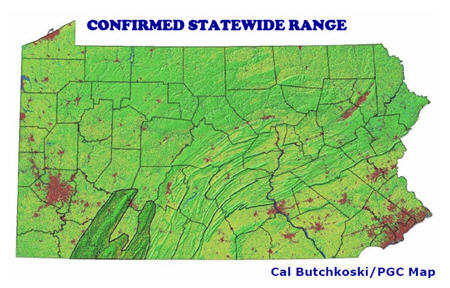Species Profile
Scientific name:
Sorex palustris punctulatus
 Print
Print
Current Status: In Pennsylvania, the West Virginia water shrew is listed as threatened and protected under the Game and Wildlife Code. It is a priority species in the state Wildlife Action Plan. Nationally, this species is considered secure.
Population Status: Although the West Virginia water shrew
(Sorex palustris punctulatus) is known to occur at several locations in southwestern Pennsylvania, the size of the populations and extent of their range within the state remain unknown. Scientists believe that, compared to more common species of shrews, the water shrew exists in very low densities where in does occur. Because of this, population trends remain unknown. This subspecies is restricted to the Appalachian-Allegheny Mountains from the Georgia-Tennessee-North Carolina border area northward into southwestern Pennsylvania, where it has been found at a few sites on the Allegheny Plateau.
 Identifying Characteristics: This semi-aquatic shrew is nearly six inches long, including a 2¾-inch tail, making it the second largest shrew in the state. Its velvety fur appears dark gray to al-most black on the upper body and tail, and grayish to light brown below. The hind feet, used as paddles when the shrew swims, are slightly webbed toward the base of the foot and fringed with specialized hairs. Water shrews are very capable divers and can stay underwater for more than 45 seconds. They remain active during winter, continuing to dive for prey. In Pennsylvania, West Virginia water shrews are found only on the Allegheny Plateau in a few southwestern counties.
Identifying Characteristics: This semi-aquatic shrew is nearly six inches long, including a 2¾-inch tail, making it the second largest shrew in the state. Its velvety fur appears dark gray to al-most black on the upper body and tail, and grayish to light brown below. The hind feet, used as paddles when the shrew swims, are slightly webbed toward the base of the foot and fringed with specialized hairs. Water shrews are very capable divers and can stay underwater for more than 45 seconds. They remain active during winter, continuing to dive for prey. In Pennsylvania, West Virginia water shrews are found only on the Allegheny Plateau in a few southwestern counties.
Biology-Natural History: The diet of the West Virginia water shrew remains unstudied, but most likely is comparable to that of the northern water shrew, which includes stonefly, caddisfly and mayfly nymphs, as well as crane fly larva. Other probable foods are snails, slugs, crayfish, earth-worms, small fish, eggs and salamanders. They are believed to be reproductively active from late February through late summer, producing two to three litters annually, usually with 6 young per litter.
Preferred Habitat: High-elevation mountain streams with high-water quality, moderate flow, and deeply undercut banks provide the best habitat. This shrew is not usually found in steep gradient streams. The West Virginia water shrew has been found most often in mixed coniferous and deciduous forests with tree canopy closure of up to 90 percent and a moderate understory.
Reasons for Being Threatened: The West Virginia water shrew appears to be restricted to a very limited range in Pennsylvania and population densities are low. Disturbances to their forest environments that result in warming or sediment in streams, or changes in pH, are likely to negatively affect the species. Although high-quality habitat exists in relatively undisturbed areas of the Allegheny Plateau, increased road building, logging, and development in surrounding habitats may sever dispersal corridors between populations and cut off populations from sources of repopulation after disturbances such as flooding or forest fire.
Management Programs: At present, there is no Conservation Management Plan for this species because few researchers have been involved with the West Virginia water shrew subspecies. Objectives and targets listed in the state's Wildlife Action Plan include maintaining populations within its presently known range in Pennsylvania, and maintaining a basic landscape that promotes its occurrence and successful dispersal between known populations. Useful actions would include development of a network of cooperators to locate existing viable habitat, development of a stream condition database, inventory and monitoring of known populations to identify small- and large-scale habitat characteristics, and review of proposed development for areas surrounding known populations.
Sources:
Beneski J. T., Stinson D. W. Sorex palustris. Mammalian Species No. 296: 1-6. American Society of Mammalogists.
Boernke W. E. 1977. Comparative Biochemical Physiology. 56:113-116.
Whitaker J. O., Hamilton W. J. Jr. 1998. Mammals of the eastern United States. Comstock Publishing Associates, Cornell University Press. Ithaca, New York. 583 pp.
Suggested Further Reading:
Kurta A. 1995. Mammals of the Great Lakes Region. The University of Michigan Press. Ann Arbor, Michigan. 376 pp.
Editorial Note: Photos of West Virginia water shrews were unavailable for this account. Those depicted are of Pennsylvania's northern water shrew (Sorex palustris albibarbis), found largely along the state's northern tier, east of the Allegheny River.
By Eileen Butchkoski
Pennsylvania Game Commission
9/9/2014